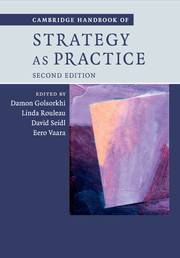Book contents
- Frontmatter
- Contents
- List of figures
- List of tables
- List of boxes
- List of contributors
- Preface to the Second Edition
- Introduction: what is strategy as practice?
- Part I Ontological and Epistemological Questions
- Part II Theoretical Resources: Social Theory
- Part III Theoretical Resources: Organization and Management Theories
- 16 An institutional perspective on strategy as practice
- 17 Relating strategy as practice to the resource-based view, capabilities perspectives and the micro-foundations approach
- 18 Theory of routine dynamics and connections to strategy as practice
- 19 Identity work as a strategic practice
- 20 Sensemaking in strategy as practice: a phenomenon or a perspective?
- 21 The communicative constitution of strategy-making: exploring fleeting moments of strategy
- 22 Analytical frames for studying power in strategy as practice and beyond
- 23 A critical perspective on strategy as practice
- Part IV Methodological Resources
- Part V Substantive Topic Areas
- Index
- References
18 - Theory of routine dynamics and connections to strategy as practice
from Part III - Theoretical Resources: Organization and Management Theories
Published online by Cambridge University Press: 05 October 2015
- Frontmatter
- Contents
- List of figures
- List of tables
- List of boxes
- List of contributors
- Preface to the Second Edition
- Introduction: what is strategy as practice?
- Part I Ontological and Epistemological Questions
- Part II Theoretical Resources: Social Theory
- Part III Theoretical Resources: Organization and Management Theories
- 16 An institutional perspective on strategy as practice
- 17 Relating strategy as practice to the resource-based view, capabilities perspectives and the micro-foundations approach
- 18 Theory of routine dynamics and connections to strategy as practice
- 19 Identity work as a strategic practice
- 20 Sensemaking in strategy as practice: a phenomenon or a perspective?
- 21 The communicative constitution of strategy-making: exploring fleeting moments of strategy
- 22 Analytical frames for studying power in strategy as practice and beyond
- 23 A critical perspective on strategy as practice
- Part IV Methodological Resources
- Part V Substantive Topic Areas
- Index
- References
Summary
Introduction
Recent research in the fields of both routines and strategy has used practice theory to focus attention on the dynamic and generative processes that result in strategy and routines and that have previously been studied as relatively static entities (Jarzabkowski 2005; Feldman and Orlikowski 2011; Whittington, this volume). Strategy as practice and the theory of routine dynamics are, thus, distinct but related theories of organizing. In this chapter I discuss similarities and synergies between the study of routines as dynamic processes and the study of strategy as practice. I focus particular attention on the emergent and mutually constituted nature of these organizational processes. I argue that these characteristics make the a priori identification of analytical entities difficult and misleading. As a result, definitions of routines and strategy, or of processes that constitute them, need to be developed in the context of specific empirical settings and specific research questions.
This chapter is written from the perspective of routines and seeks to identify some of the ways in which routine dynamics can contribute to strategy-as-practice research. The theory of routine dynamics is not only a compatible theory but also a useful tool for the study of strategy as practice. Accordingly, I begin the chapter with a description of routine dynamics. In the second section I discuss the connections between routine dynamics and strategy as practice. The third section explores challenges that research in routine dynamics and strategy as practice have in common, specifically the issue of identifying relevant action and enacted patterns and issues of multiplicity, or the ‘problem’ of identifying a singular routine or strategy. The fourth section presents studies of routine dynamics that contribute to strategy as practice and that show how strategies emerge through routines. Methodological implications are summarized briefly in the conclusion.
Theory of routine dynamics
In recent years a theory of routines has developed through the work of many scholars. The foundational work was provided by Martha Feldman and Brian Pentland, each working independently and, later, jointly. Pentland's work developed the idea of routines as effortful accomplishments (Pentland and Reuter 1994). Feldman's work built on this idea and pointed out that routines were not only effortful but also emergent (Feldman, 2000).
- Type
- Chapter
- Information
- Cambridge Handbook of Strategy as Practice , pp. 317 - 330Publisher: Cambridge University PressPrint publication year: 2015
References
- 13
- Cited by



